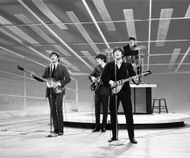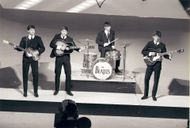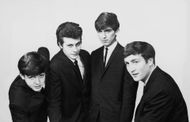It is practically impossible to imagine the history of modern music without the Beatles, as it is nearly impossible to imagine a colorless world. Not only did they define the tone of their era, but the attitude, experimentation, and artistic aspiration of legions of artists who came in their wake. What is even more interesting about their journey is the fact that it all occurred within such a small period.
In less than a decade, they transformed music history, creating the new definition of what a band should be: a group of mop-topped heartthrobs who were transformed into a group of studio innovators that composed rock and pop melodies infused with classical, Indian, and avant-garde beats into a completely new phenomenon.
Nevertheless, despite the ubiquitousness of its existence in social history, the period of the live Beatles onstage lasted shockingly short. They were already in retreat on touring, preferring by the mid-1960s to concentrate on the artistic potential of the recording studio.
This was a huge and, at the time, unprecedented move, and the result was that every live show that they actually did play was all the more special, recorded not only as a musical moment but also as a moment of scarcity. During a time when most musicians depended to a large part on bi-weekly tours to stay afloat, the Beatles breaking off to go back to their roots of pure music helped them stand out.
It's not just the long years or the trio that keep their story alive, but a bright, short burst of greatness that still fires up many music types. The Beatles weren't just a band; they shook the world of music groups like an earthquake, and their brief yet lively run only made their legend last forever.
The live shows of the Beatles made a huge change in the bond between stars and their fans. Even though they did not tour for long, they were key in teaching us about big crowd draws and the power of live music for all.
Their concerts were the earliest ones to attract crowds never seen before, create media hysteria, and create a celebrity out of musicians. They preconditioned the emergence of modern concert experience, when the image, the spectacle, and the contact with the audience were as important as the music. Although they ultimately left the stage because of the sound conditions and extreme burden of fame, the trace of their performances remained.
Their presentation itself changed the way stage presence and dealing with the fans would be thought about in the future by the artists, as well as the logistics of conducting a stage at scale. Possibly the most enduring innovation of the Beatles is their studio work, but their theatrical performance changed the history of live performance and is heard in stadiums and concert halls worldwide even today.
Disclaimer: This article contains the writer's opinion. The reader's discretion is advised!
Here are the top 5 The Beatles' stage performances of all time
Here are the top 5 The Beatles' stage acts of all time. These times shine not just for the tunes but for their past and world worth. From tight early club gigs to big TV spots and huge field shows, each act was a key point in their climb and pull. These acts got the vibe of Beatlemania, showed the band’s growing link, and shed light on the big change in how we hear music and enjoy live acts.
Though they played live shows for only a short time, the Beatles’ gigs changed the game for world tours. From their first U.S. TV show to their last big show, each event left a deep mark. It touched not just fans but also the road ahead for live music.
1) The Beatles at Candlestick Park in San Francisco, California, in 1966
In August 1966, The Beatles got on the stage at San Francisco's Candlestick Park. This was set to be their last live show for people who paid to see them, a time that marked an end to a part, not a time for joy. By then, the fun of doing live shows was gone, taken over by being too tired and losing heart.
By the time of their last show, The Beatles were at a key turn. They still played loved rock songs and added soft tunes from Rubber Soul like Nowhere Man and If I Needed Someone, but the air felt a bit unsure. Paul's slow start to Paperback Writer showed the group's unsure feelings about what was next.

With Revolver just out, they were moving more to the studio, planning to stop touring for good. This change began a new time of bold sound trials, leading to big albums like Sgt. Pepper's, The White Album, and Abbey Road. Even as their music got deeper, moving away from live shows was a quiet sign of the end that would come to the band.
The band was tired of the same old tour routine, where loud screams from fans often made it hard to hear the music, and bad sound gear made their music get lost in the noise. But it wasn't only the mess of plans that tired them out. A big culture shift was also at work. John Lennon's words about The Beatles being "more popular than Jesus" caused anger in some parts of the United States, mainly among those with strong faith.

This led to protests, people not buying their stuff, and even public burnings of their music. What used to be a happy time of music and being together now seemed risky, tight, and more and more empty.
Though the people there didn't know, the band gave the show a sense of it being the last one. They even took their own photos and brought cameras to keep the memory. The Beatles didn't say goodbye; they just walked offstage and stopped doing live shows, ending that part of their work and starting a phase of studio work that shaped their famous career.
Read More: Top 10 'The Beatles' songs that still echo through time
2) The Beatles' Live at Shea Stadium - August 15, 1965
In August 1965, The Beatles played live at New York's Shea Stadium and changed how big a live show could be. More than 55,000 fans filled the place, making it one of the first big stadium shows in music history and setting a new standard for big shows.
This event started their second U.S. tour and showed how wild fans were for the band at their peak. The Beatles came in an armored van and played on a small stage near second base, giving the crowd hits like A Hard Day's Night, Ticket to Ride, and I Feel Fine. The sound from the loud crowd was so much that even their strong 100-watt Vox amps could not keep up, making them use the big PA system.
Fans ran onto the field, and over 2,000 guards tried hard to keep things in check, while bright signs begged the people to stay in their seats. Even though the band could hardly hear their own play, and a lot of the sound later needed to be recorded over for the movie, the big mess and wildness of that night made it one to always remember.

Shot by 22 cameras, the show was not just a play; it was a big event that showed how The Beatles had grown to be more than a band. They were a huge deal with the power to rock big places and make lots of people go wild.
3) The Beatles' The Rooftop Concert on January 30, 1969
Years after their last big show at Candlestick Park in 1966, the Beatles came back for one last show for all to see. But this time, the place they chose was not usual. On a cold day in January 1969, the band went up to the top of their Apple Corps office in London. This was where they gave their famous last live show. The rooftop show wasn't meant to be a big goodbye, but more of an unplanned end to their movie Let It Be.
Without telling anyone and with just the city's noise down low, the Fab Four played up high as shocked people in London took a moment to hear, looking up. Wearing coats from their wives and now looking older and tougher, Paul stood out with his big beard, a big change from their young look, as they played with keyboard player Billy Preston. They gave raw versions of songs like Get Back, Don't Let Me Down, and I've Got a Feeling.
Meanwhile, folk who made music, like George Martin and a young Alan Parsons who'd later shape The Dark Side of the Moon, saw it from below. It wasn't smooth: Lennon had words held up for him mid-show, and the takes were loose and raw. Yet, the charm lay in how easy-going it was.
In the end, the police showed up due to calls about the loud sounds, and this brought things to a quick, but right end. With the sharp humor he was known for, John ended the show by talking to the people down there with words that were both fun and deep: "I'd like to say thank you on behalf of the group and ourselves, and I hope we passed the audition."
4) The Beatles live in Manila - July 4, 1966
The Beatles' 1966 trip to Manila turned bad not due to their stage show but by the mad fuss that came after. They had played to a huge crowd of about 80,000 fans at the Rizal Memorial Football Stadium, then took a day off, not knowing they had been asked by First Lady Imelda Marcos to attend a big event at the presidential home.
They did not go, not by choice, and this sparked a big mess when Marcos showed she was upset on TV. What came next was a hard and messy leave from the country, with tales of bad moods, threats, and even fights at the airport as the Beatles and their team tried to get away from the trouble.
The hard time had a deep effect on the group, showing that their big fame made it very hard to deal with hopes and talks. For a band that stood for young energy and breaking rules, the Manila event was a strong warning that being known didn't always mean being free. Often, it led to being in the middle of loud pride and mix-ups between cultures.
5) The Beatles' The Ed Sullivan Show - February 9, 1964
In February 1964, American TV saw a huge moment in pop culture when The Beatles first showed up on The Ed Sullivan Show. More than 73 million people, close to a third of the U.S. crowd back then, sat near their TVs, eager to find out what the big deal was.
Seen as the new hit from Liverpool, the Fab Four: John Lennon, Paul McCartney, George Harrison, and Ringo Starr, came onto the stage with style, matched moves, and an exciting rock 'n' roll vibe. Their song list had the fun All My Loving, a deep take on Till There Was You, and big hits like She Loves You and I Want to Hold Your Hand, all almost lost to the loud cheers of happy teen girls.
By then, the Beatles were big back home in the UK, but this show threw them right into the minds of Americans and set up a wave of their growing fame. Beatlemania had just started to catch on in the States a few weeks earlier, all due to some early talks and songs on the radio. But it was Ed Sullivan who, after seeing their rise on CBS News, made sure they got their big break.
Even Elvis Presley, who was once the top name in American music, sent a message to wish them luck. When the cameras focused on those British guys with their mop-top hair, one thing was clear: American entertainment had changed for good.
The Beatles' live shows were key in making their mark and changing how we see music today. Known for their zest, charm, and sharp skills, they had an unmatched feel on every stage they played. From small club gigs to huge stadium tours, their concerts were more than just songs; they turned into large events that made fans all over go wild. Even after they stopped touring, the thrill and impact of their shows changed music history forever.
Keep reading SoapCentral for more informative content!
Also Read: 7 stunning Method Man raps you need to hear
